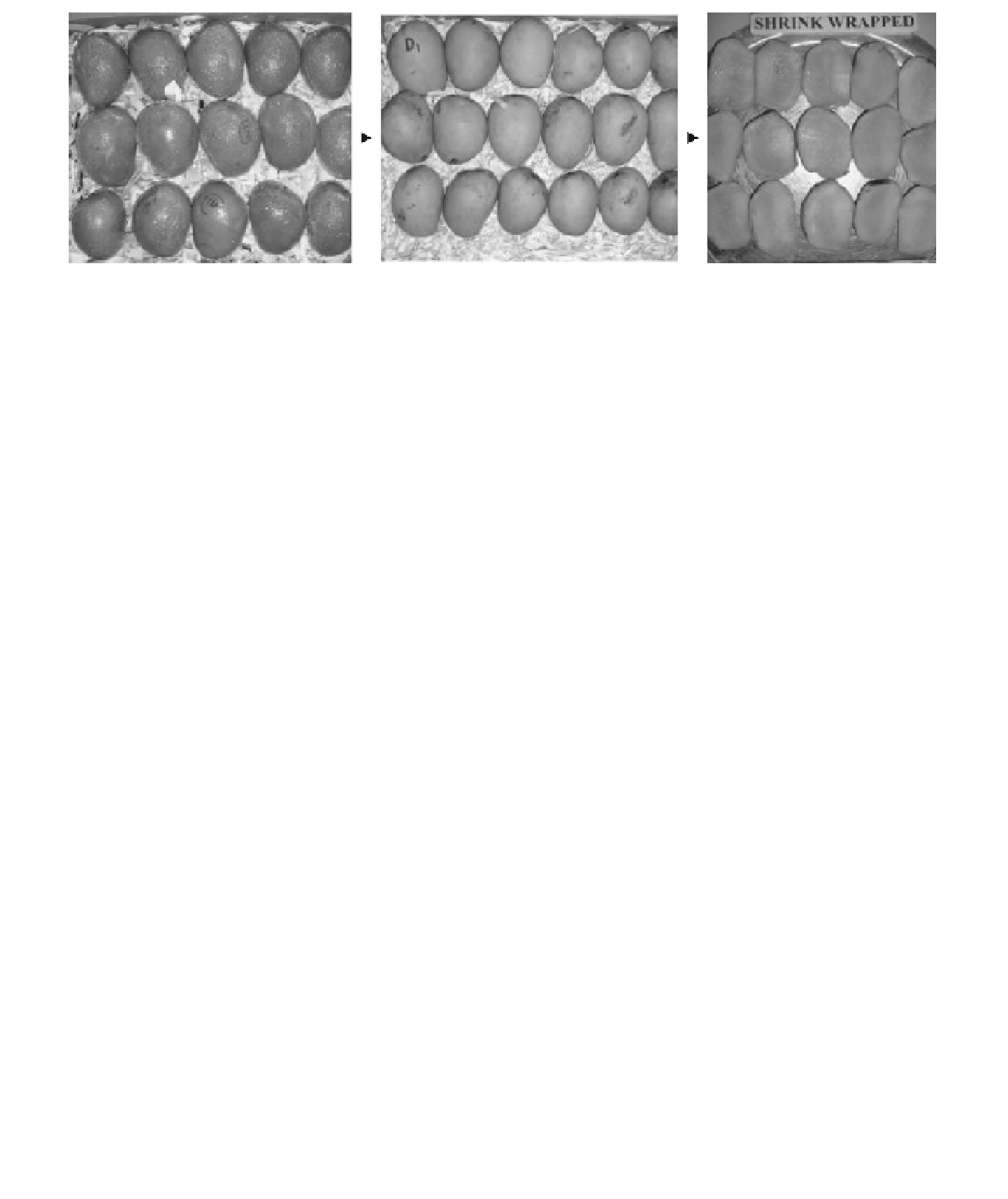Agriculture Reference
In-Depth Information
Figure 14.5.
'Alphonso' mangoes stored at 8
◦
C for 5 weeks (left), followed by 1 week ripening at room
temperature (middle), and shrink-wrapped under same conditions (right). For color detail, please see color
plate section.
Tiasuwan, 1995), 'Kent' and 'Tommy Atkins' (Lizana and
Ochagavia, 1997), 'Kensington Pride' (McLauchlan and
Barker, 1994), and 'Delta R2E2' (Lalel et al., 2005). Many
of the beneficial effects of CA storage have been attributed
to low O
2
, resulting in reduced ethylene production and
lower respiratory activity, better flavor retention, slower
softening rates, and the maintenance of higher levels of
organic acids (Thompson, 1998). The optimum concentra-
tions of CO
2
and O
2
for CA storage of mangoes vary from
one cultivar to another (Kader, 1993; Yahia, 1998).
McLauchlan and Barker (1994) stored 'Kensington'
mangoes under 36 different atmospheres consisting of com-
binations of six O
2
(2,4,5,6,8,10%)andsixCO
2
(0,2,4,6,
8, 10%) levels, at 13
◦
C for 33 days and found that 4% CO
2
+
2-4% O
2
was the optimum. However, they suggested the
use of better disease control measures for long-term storage
of mangoes under CA. Mature green 'Haden' and 'Tommy
Atkins' mangoes could tolerate 3% O
2
for 2-3 weeks at
12
◦
-15
◦
C (Bender et al., 2000). CA storage under 6% CO
2
+
CA storage in 5% O
2
+
5% CO
2
for 'Alphonso' and
in 5% O
2
3% CO
2
for 'Banganapalli' mangoes was
found to extend their storage life to 4 weeks and 5 weeks,
respectively, followed by 1 week ripening under ambient
conditions (Rao and Rao, 2008). HW treatment prior to
CA storage at 13
◦
C was found to affect quality attributes
such as fruit firmness, ascorbic acid, carotenoids, and sugar
contents, especially when CA storage lasted for more than
4 weeks in these cultivars.
CA storage alleviated the CI and extended the storage
life to 6 weeks at 8
◦
C when mango cultivars 'Alphonso'
and 'Banganapalli' were stored under CA of 5% O
2
+
+
5%
CO
2
andin5%O
2
+
3% CO
2
, respectively (Rao and Rao,
2009). Both cultivars showed good surface yellow color and
maintained optimum fruit firmness and higher TSS, sugars,
and carotenoid contents with better retention of mango fla-
vor when removed from the CA and ripened under ambient
conditions for 1 week (Fig. 14.6). Youngmok et al. (2007)
investigated the changes in antioxidant phytochemicals
and resultant quality during storage and ripening in fresh
mangoes, as influenced by application of CA in combi-
nation with a hot water immersion quarantine treatment
(46
◦
C for 75 min). Visible appearance of anthracnose dur-
ing ripening was effectively inhibited by the hot water treat-
ments combined with CA. Concentrations of gallic acid and
numerous hydrolysable tannins and their resultant antioxi-
dant capacity were unaffected by the hot water treatment,
while total polyphenolics naturally decreased throughout
fruit ripening, regardless of hot water treatment or storage
atmosphere. However, the overall decline in polyphenolic
concentration was inhibited by the CA treatments, as a re-
sult of delayed ripening.
Optimum CA conditions have been reported for dif-
ferent cultivars of mangoes grown in different parts of
3% O
2
was found to extend the shelf life of 'Delta R2E2'
mangoes for up to 38 days at 13
◦
C, with normal fruit ripen-
ing, good taste, high TSS, a high TSS to titratable acid-
ity (TA) ratio, and high total sugars content (Lalel et al.,
2005).
Anthracnose and stem-end rot are the principal limiting
factors during storage of mango, and without any pretreat-
ment, there was limited disease control by CA under the
moderate O
2
(
5%) levels tolerated by
mango over extended storage periods at 12
◦
-15
◦
C(Yahia,
1998). Johnson et al. (1990) reported that during long-term
CA storage of 'Kensington Pride' mangoes at 13
◦
Cfor
26 days in 5% CO
2
+
≥
5%) and CO
2
(
≤
3% O
2
, followed by 11 days in air at
20
◦
C and hot benomyl, followed by prochloraz prior to stor-
age, effectively controlled stem-end rot and anthracnose.

Search WWH ::

Custom Search